What is Damask? Woven Fabric for Elegant Brand Labels
Ever wondered about damask and admired its subtly shifting, woven-in patterns? This guide explores this unique fabric: from its rich history and intricate manufacturing process to its diverse applications. You’ll understand why this luxurious fabric, with patterns that uniquely catch the light, is a superior choice for high-quality brand labels.
Discover how damask can impart an unmatched sophistication, making it a favored material at Packlove for brands aiming to elevate their product presentation and perceived value.
1. What exactly is damask fabric?
Damask is a fabric where the pattern is created by the way the threads are woven together. The design is part of the fabric itself, not printed on with ink. Think of it like the picture is made from the threads.
A notable feature of damask is that the pattern is often visible on both sides of the fabric. Interestingly, if the pattern is shiny on the front, it will likely be matte (not shiny) on the back. And the background will do the opposite! So, it’s like getting two looks in one piece of fabric.
For example, imagine a woven flower. On the front, the flower might be shiny and the background matte. Flip it over, and the flower could be matte with a shiny background.
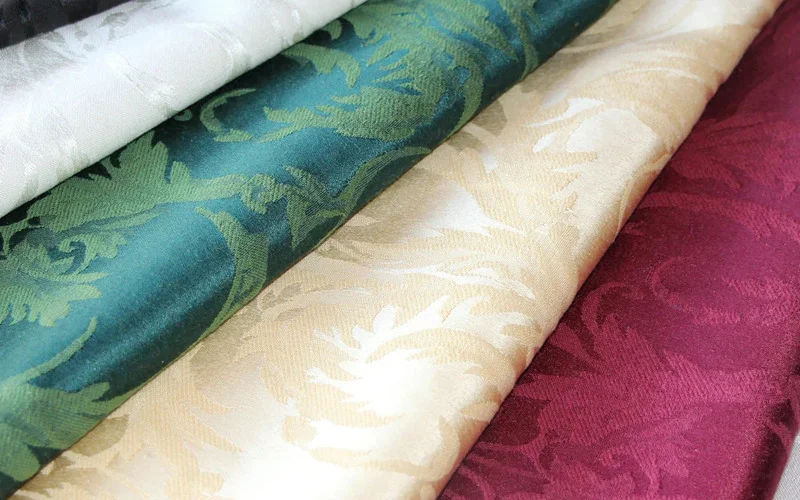
Damask has a special, elegant look because of how it’s woven. Some parts of the pattern will look shiny, almost like satin, while the background or other parts of the pattern will look more matte (dull or flat). This contrast between shiny and matte areas makes the pattern stand out beautifully and look very rich.
Remember, the pattern in damask isn’t made with ink or dye on top of the fabric. It’s created by the threads themselves during the weaving process. Special weaving techniques make the design appear as an integral part of the fabric’s structure. This is why the pattern is so durable.
At Packlove, we love damask for labels precisely because this woven-in pattern means your brand design won’t easily fade, rub off, or disappear with washing. It’s all about creating a label that lasts and continues to represent your quality.
Key features of damask:
- Pattern woven in, not printed.
- Often reversible with opposite effects.
- Mix of shiny and matte areas.
- Durable design.
2. A quick look back: The history of damask
The name ‘Damask’ originates from Damascus, an ancient city in modern-day Syria, renowned centuries ago for producing these beautiful woven fabrics with intricate patterns.
Historically, damask fabric was a highly prized and often costly luxury. Kings, queens, and rich people used it for their fanciest clothes. They also used it to decorate their homes with beautiful curtains and furniture coverings. Having damask showed that they had good taste and wealth.
Over time, the secret and skill of making damask fabric traveled. It went from the Middle East to other parts of the world, like Europe. There, it also became highly valued.
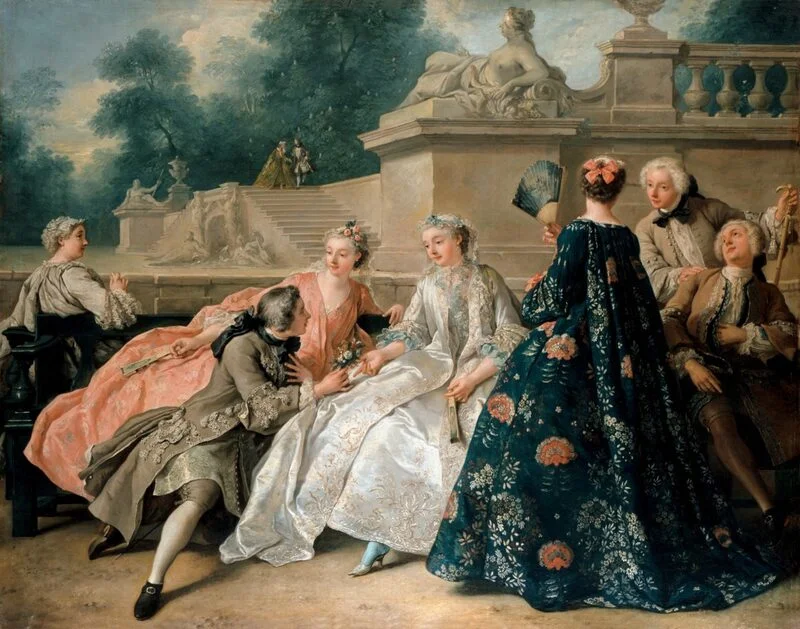
3. How is damask made? The art of the weave
Damask is usually made on a special machine called a Jacquard loom (pronounced ‘ja-KARD’). Think of this loom as a very smart and complex weaving machine. It can control hundreds, or even thousands, of individual threads at once. This allows it to create very complicated patterns directly into the fabric as it’s being woven.
All fabric is made by weaving threads together. There are threads that go up-and-down the length of the fabric – these are called ‘warp’ threads. Then there are threads that go side-to-side, across the fabric – these are ‘weft’ threads. In damask, the Jacquard loom lifts certain warp threads and passes the weft thread underneath. Or it lets some warp threads sit below the weft thread.
Where many warp threads ‘float’ over the weft for a short distance, it creates a smooth, shiny area. This is often a satin weave technique. The pattern is formed by contrasting these shiny areas with areas woven differently, which look more matte.
This special weaving technique allows for very detailed and complex designs. Flowers, leaves, swirls, or even small logos and text can be made right into the fabric itself.
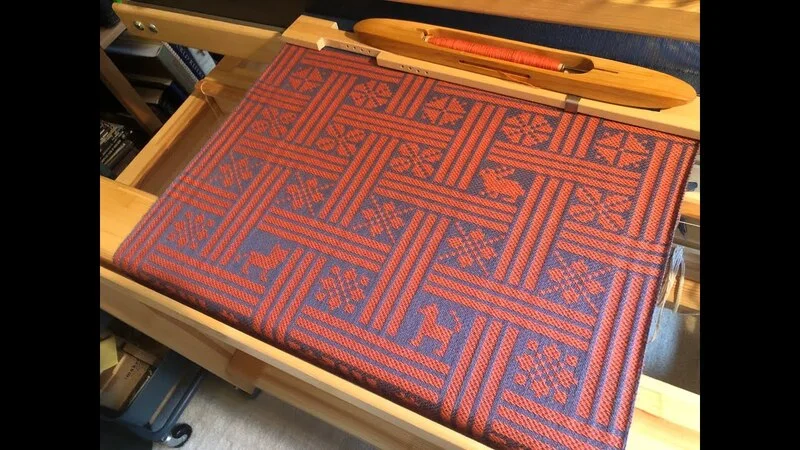
Materials Used:
- In the past, damask was often made from natural fibers – threads that come from plants or animals. Common ones were silk, linen, cotton, or wool.
- Today, especially for things like brand labels on clothes and other products, polyester is a very popular material for making damask. Polyester is a popular choice because it is very strong and resistant to fading from washing or sunlight. It can be washed many times without damage. Most importantly, polyester threads can be made very fine. This allows weavers to create extremely sharp and clear details – which is perfect for small logos and tiny text on brand labels! For these reasons, Packlove often recommends polyester for Damask labels. It gives great results that last.
- From our experience producing many custom labels at Packlove, we’ve found that polyester damask consistently delivers the clearest details for complex logos. It also offers the best durability for everyday products. It balances beauty with practicality perfectly for branding.
4. What does damask look and feel like?
Damask patterns are often very elegant and can be quite detailed. You might see beautiful designs like flowers, leaves, fancy swirls, or geometric shapes. The most interesting part is how the light plays on the shiny and matte parts of the weave.
This makes the pattern seem to appear and disappear. It can look lighter and darker as the fabric moves or as you look at it from different angles. It gives the fabric a rich, textured look.
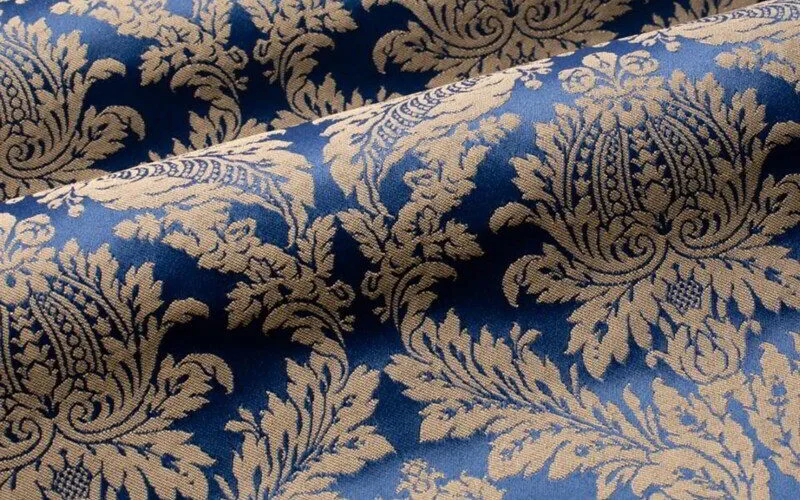
Damask fabric usually feels smooth and pleasant to the touch. Depending on the design and materials, the patterned area can sometimes feel slightly raised compared to the background. It might also have a subtly different texture. This enhances its tactile appeal, making it feel more luxurious than a plain, flat fabric.
5. Common uses of damask: Beyond tablecloths
Due to its beauty and luxurious feel, damask has long been used for fine home furnishings.
- In the Home: Think of elegant tablecloths and napkins for special dinners, rich curtains for windows, and to cover furniture like sofas and chairs.
- For Clothing: It was also used for special clothing, like expensive dresses, formal vests, or jackets.
Today, damask is still very popular for home decor if you want an elegant touch. You can also find it used in high-end fashion. For example, in special occasion dresses, stylish jackets, ties, scarves, and even handbags.
So, with all these fine qualities, what makes damask particularly appealing for Packlove? Its beautiful patterns, its luxurious feel, and its amazing ability to show off fine detail make damask an excellent choice for brand labels. These labels can be on clothing, bags, home textiles, and other quality products.
A damask label sends a message to your customer. It says that your product is special, well-made, and that you care about every detail. At Packlove, we often see brands choose damask when they want their label to truly reflect the premium nature of their items.
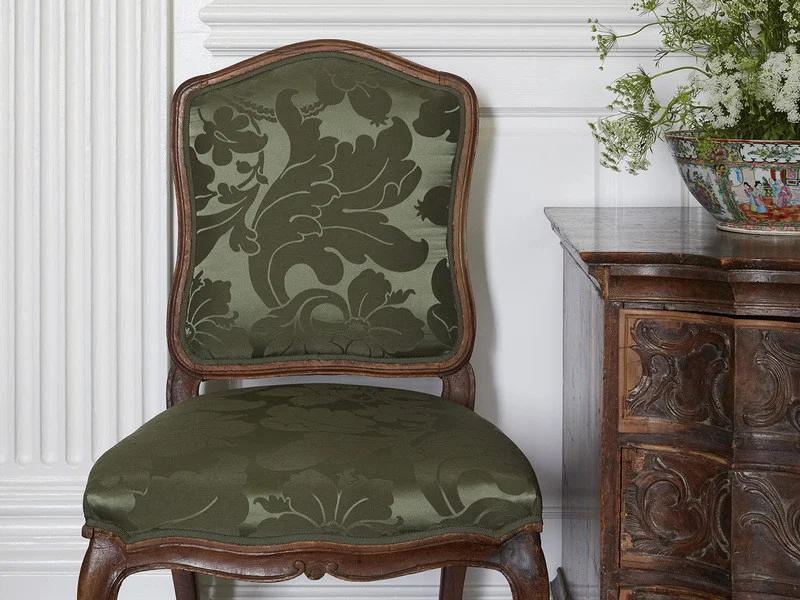
6. Damask for your brand: Why choose damask woven labels from Packlove?
At Packlove, we offer beautiful Damask Woven Labels that can make your brand look truly professional and stand out from the competition.
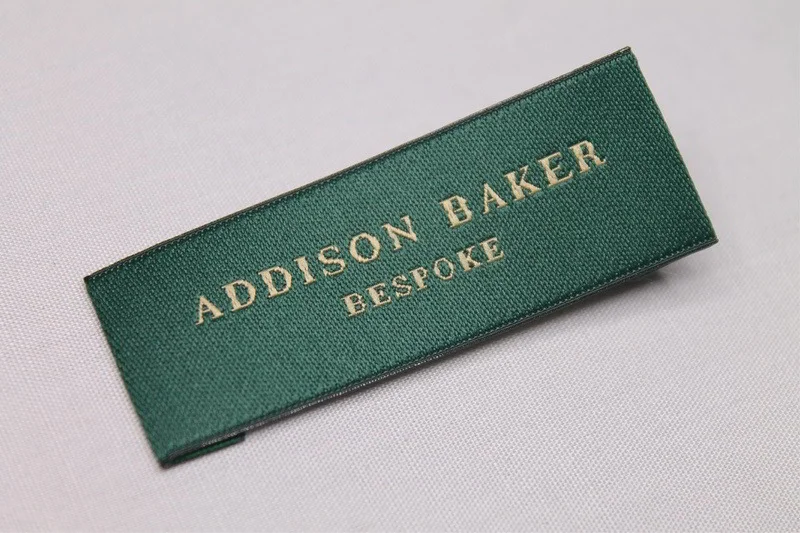
Here are the benefits for your branding:
- Exceptional Detail for Logos & Text: The damask weave is amazing for showing off tiny details. If your logo is intricate, has fine lines, or includes small text, damask labels can make it look incredibly sharp and clear. This is crucial for a professional brand image that people remember.
- Luxurious Feel & Appearance: A damask label doesn’t just look good; it feels soft and high-end. When customers touch it, it adds a touch of luxury to your products. It signals that you care about overall quality, right down to the label.
- Durability for Long-Lasting Brands: Our damask labels, usually made from high-quality polyester, are very strong and built to last. They can handle repeated washing and daily wear. So your brand name and logo look great for a long time. Our clients appreciate the exceptional durability of these labels.
- High-Density (HD) Damask for Ultimate Detail: For the absolute best, sharpest detail, Packlove offers High-Density (HD) Damask labels. This means we use even more threads, and these threads are even finer, to weave your design. The result is incredibly super-sharp images and text. It also gives an extra smooth, very premium feel. HD damask is perfect when your design is extremely detailed. It’s also great when you want the most luxurious branding possible. For example, if you have delicate script writing or a complex small emblem, HD damask is often the best choice.
Packlove’s Material Choices:
We primarily use polyester for our damask labels. As mentioned, polyester offers significant advantages. It’s strong, the colors stay bright through washing, it resists shrinking, and it allows us to weave those tiny, beautiful details that make damask so special. It is a reliable and effective material for high-quality, durable labels.
Are you looking for a beautiful label that’s also a bit kinder to our planet? Packlove is proud to offer damask woven labels made from recycled polyester. You get the same amazing detail, vibrant colors, and premium quality. But you’re choosing a more sustainable option. Many brands are now looking for eco-conscious choices, and we’re happy to provide this for your labels.
Our experienced team at Packlove is here to help you. We can look at your logo or design idea. We can advise you on whether standard damask or HD damask would be better for your specific needs. We’ll make sure your design translates perfectly into a stunning woven label. We can also guide you on thread color choices to ensure your design really pops!
7. Damask labels vs. other woven label types
When you’re looking for woven labels, you might hear about other types besides damask, like taffeta or satin. Here’s a very quick guide to help you understand the main differences:
- Taffeta Labels: Characterized by a more basic, simpler weave, taffeta is less suitable for very fine details or complex logos. Edges can sometimes be a bit rougher if not finished well. In terms of feel, taffeta can be a bit stiffer or more papery than damask or satin. It is commonly used for care instruction labels or basic branding where super fine detail isn’t the top priority.
- Satin Labels (Woven, not printed satin ribbon): These have a very smooth, shiny surface (it’s flat, not usually patterned like damask) and can be good for some logos, though damask usually offers even better detail resolution for intricate patterns. Satin labels feel very soft and smooth with a noticeable sheen and are popular for branding on lingerie, baby clothes, or items where a very soft, shiny label is desired.
- Damask Labels (from Packlove): These feature intricate woven-in patterns, often reversible with a textured, rich look, and are excellent for very fine details, small text, and complex logos (especially our HD Damask). They feel soft, luxurious, with a pleasing, slightly textured feel from the woven pattern, making them ideal for premium branding on all types of apparel, accessories, and high-quality goods.
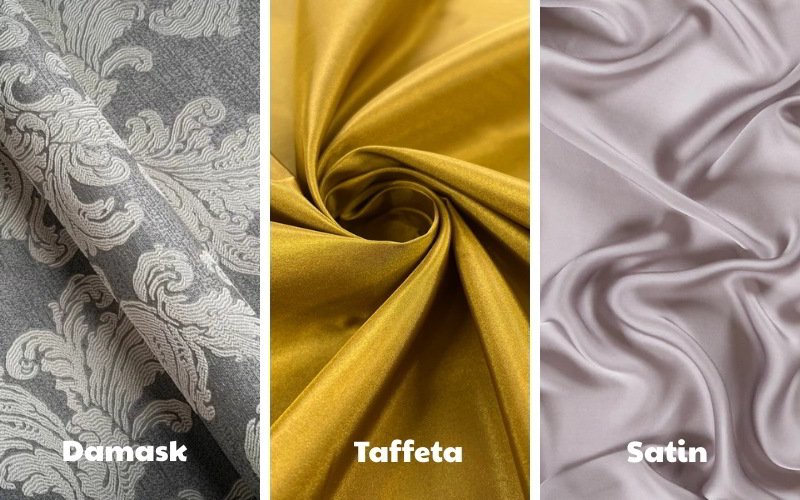
So, when should you choose damask? If you have a very detailed logo or tiny text, damask is usually the top choice. It can show these details much more clearly than taffeta. It often shows them even better than standard satin labels. Moreover, damask generally offers a more high-end and sophisticated look and feel due to its unique, rich woven patterns.
At Packlove, we’re happy to discuss your specific design and product. But as a general guide, if your priority is the absolute best detail, a luxurious feel, and a label that clearly communicates ‘quality’ for your main brand identity, damask is very hard to beat.
8. Designing and ordering your damask woven labels with Packlove
Here are some tips for great damask label design:
- Good Color Contrast is Key: For your design to really stand out on a woven damask label, make sure to choose thread colors that have good contrast. For example, a light-colored design on a dark background thread, or a dark design on a light background thread, usually looks best.
- Keep Text Clear and Readable: While damask is amazing for detail, it’s still important that any text on your label is large enough to be easily read. Our Packlove team can give you advice on minimum text sizes that work well.
- Vector Artwork is Best: For the sharpest, cleanest results, it’s best if you can provide your logo or design as a vector file. These often end in .AI, .EPS, or .SVG. If you don’t have one, don’t worry, we can help!
- Think About Folds & Stitches: Consider how your label will be sewn onto your product. Packlove offers different folding options to suit different applications. We can show you examples!
- Sometimes, Simpler is Stunning: Very complex designs can look amazing in damask. But sometimes a clean, simpler design can be just as impactful. We can help you decide what will look best for your brand.
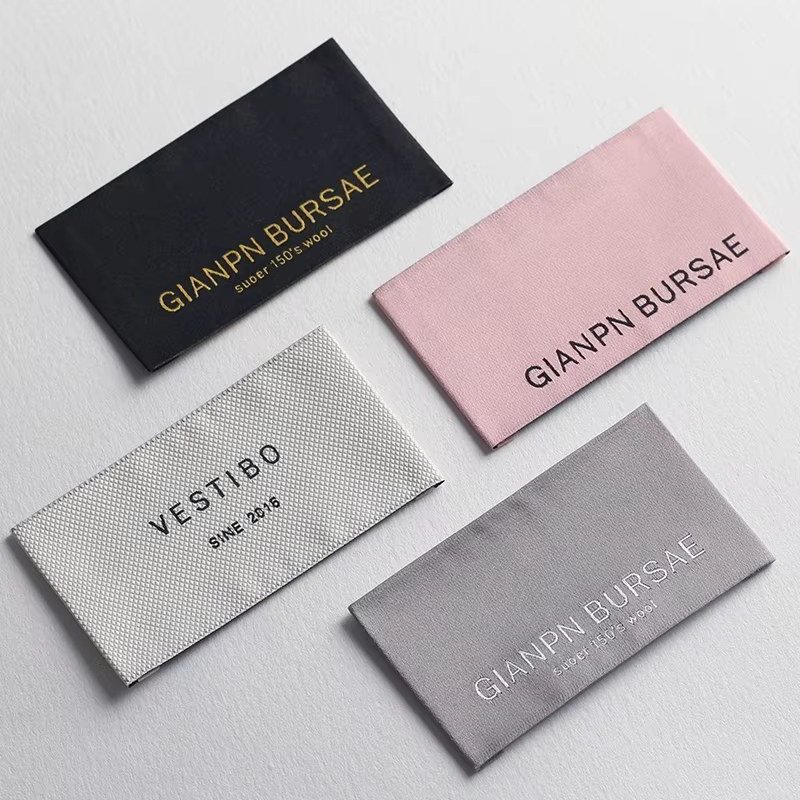
Ordering from Packlove is easy:
- Ready to get started? First, visit Packlove.
- Navigate to the ‘Woven Labels’ section and choose ‘Damask Woven Labels’.
- You can upload your existing design file, or just tell us about your idea – what you want the label to say or show.
- Let us know the size you want your label to be. Tell us how many labels you need (your quantity). Let us know if you have a preference for any special finishes, like a particular type of fold.
- Our team will then prepare a clear price quote for you. We’ll also create a digital proof for you to check.
- Once you look at the proof and tell us everything is perfect (you approve it), we’ll get to work making your beautiful custom damask labels!
Not a design expert? Or feeling a bit unsure about your artwork? No problem at all! The friendly Packlove team is here to help. We can review your artwork to make sure it will look fantastic as a damask label. We can suggest improvements if needed. We can even help you create a design from scratch based on your ideas. Just reach out to us!
9. Frequently asked questions (FAQs) about damask and damask labels
9.1 What is damask?
Damask is a special type of fabric where the pattern is woven directly into the material itself, not printed on top. This unique weaving technique creates a design that is often reversible. This means it can be seen on both sides, sometimes with opposite shiny and matte effects. It is known for being very detailed and luxurious.
9.2 Is damask fabric strong and durable enough for labels?
Absolutely. Especially when damask labels are made from modern, high-quality materials like polyester (which Packlove typically uses), they are very strong and durable. They are designed to last through many washes and everyday wear and tear. The design won’t fade, fray, or lose its detail. They are built for longevity on your products.
9.3 Why are damask labels often used for high-end clothing and products?
Damask labels have a very luxurious look and a soft, premium feel. They are excellent at showing off very fine details in logos and text. This adds a touch of class, sophistication, and perceived value to any item. Using a damask label signals to customers that the brand cares about every detail. It shows commitment to quality.
9.4 Can I get very small text or complicated logos on a damask label?
Yes, damask is one of the best choices for this! Its special weaving process allows for very intricate designs. Tiny letters and complex logos can be reproduced with impressive clarity and sharpness. For designs that need the absolute finest detail, Packlove also offers High-Density (HD) damask labels. These use even finer threads for maximum precision.
9.5 How is a damask woven label different from a printed label?
The biggest difference is how the design is created. In damask woven labels, your design is formed by weaving different colored threads together – the design is the fabric. In printed labels, ink is applied onto the surface of a plain piece of fabric.
Generally, woven designs like damask last much longer. They feel more textured and premium. They won’t crack, peel, or fade over time in the same way some printed inks can. From our experience at Packlove, woven labels offer a more integrated and durable branding solution.
9.6 What materials are usually used for damask labels today?
Polyester is the most common and often the best material for modern damask labels. This is because polyester is very strong. It holds its color extremely well (it’s colorfast). It is resistant to shrinking and stretching. It can be woven into extremely fine threads.
These fine threads are what allow us to create those beautiful, highly detailed damask patterns. As a bonus, Packlove also offers damask labels made from recycled polyester. This gives you a high-quality, eco-friendlier option.
Read more:
As you’ve now discovered, damask is a truly special woven fabric. It’s famous for its beautiful, often reversible patterns. It’s known for its elegant and luxurious look. And it has an incredible ability to show off amazing detail in designs.
All these wonderful qualities make damask an outstanding choice for brand labels. If you want your labels to look and feel high-quality, sophisticated, and detailed, reflecting the true value of your brand, damask is a fantastic option.
If you’re ready to give your products that extra touch of class and professionalism with custom damask woven labels, the team at Packlove is here. We are excited to help you create the perfect ones for your brand. Explore our damask label options on our website. Or get in touch with us today for a friendly chat and a no-obligation quote!






















